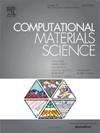On the numerical sensitivity of cellular automata grain structure predictions to large thermal gradients and cooling rates
IF 3.1
3区 材料科学
Q2 MATERIALS SCIENCE, MULTIDISCIPLINARY
引用次数: 0
Abstract
Cellular automata (CA) models of as-solidified grain structure, originally developed and applied to casting, have become a common means of predicting grain structure resulting from Additive Manufacturing (AM) processes. The majority of these models are based on the decentered octahedron approach, which attempts to correct for the effect of grid anisotropy on the prediction of competitive solidification of dendritic grains. However, AM solidification occurs under cooling rates () and thermal gradients () that are orders of magnitude larger than those encountered in casting, and no systematic investigation on the effect of the CA model cell size () and time step () on AM microstructure predictions has been performed. In this study, such an investigation is first performed via simulation of individual grains of various crystallographic orientations with a fixed, unidirectional , showing that CA prediction of the steady-state undercooling matched the expected values based on the interfacial response function at small and deviated from the expected values at large . Simulation of competitive growth of multiple grains showed a weakening of the predicted texture as and became large. Simulation of solidification under AM conditions, where and vary spatially across the melt pools, showed that not only does grain selection weaken and deviate from expectations at large , but grains with crystallographic aligned with the grid directions are more adversely affected by the temperature field discontinuities than grains with other crystallographic orientations. Despite the fact that the exact grain competition results depended on , the overall texture development was notably less sensitive to than , provided that a reasonable value of is selected based on the ratio of to the maximum local solidification velocity in the simulation domain. Finally, from the directional solidification and AM simulation results, an analysis of computational cost compared to simulation resolution is performed based on an equation derived to quantify the relatively inaccuracy in grain selection based on the model and temperature field inputs. From this analysis, it is concluded that there is a need for algorithmic improvements to improve CA grain competition accuracy for large processing conditions as sufficiently small to resolve the necessary competition is intractable for many AM processing conditions.

求助全文
约1分钟内获得全文
求助全文
来源期刊

Computational Materials Science
工程技术-材料科学:综合
CiteScore
6.50
自引率
6.10%
发文量
665
审稿时长
26 days
期刊介绍:
The goal of Computational Materials Science is to report on results that provide new or unique insights into, or significantly expand our understanding of, the properties of materials or phenomena associated with their design, synthesis, processing, characterization, and utilization. To be relevant to the journal, the results should be applied or applicable to specific material systems that are discussed within the submission.
 求助内容:
求助内容: 应助结果提醒方式:
应助结果提醒方式:


